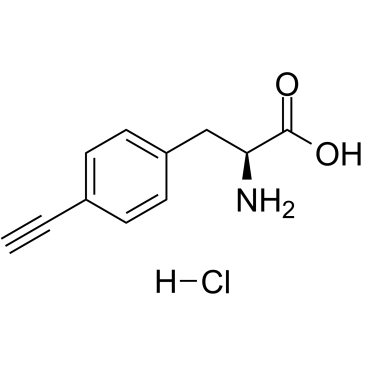4-Ethynyl-L-phenylalanine hydrochloride
Modify Date: 2025-08-26 23:42:20

4-Ethynyl-L-phenylalanine hydrochloride structure
|
Common Name | 4-Ethynyl-L-phenylalanine hydrochloride | ||
|---|---|---|---|---|
| CAS Number | 188640-63-3 | Molecular Weight | 225.67 | |
| Density | N/A | Boiling Point | N/A | |
| Molecular Formula | C11H12ClNO2 | Melting Point | N/A | |
| MSDS | N/A | Flash Point | N/A | |
Use of 4-Ethynyl-L-phenylalanine hydrochloride4-Ethynyl-L-phenylalanine hydrochloride is a selective, reversible, potent and competitive inhibitor of tryptophan hydroxylase (TPH). 4-Ethynyl-L-phenylalanine hydrochloride is a competitive inhibitor with regard to the substrate tryptophan, with a Ki of 32.6 μM. 4-Ethynyl-L-phenylalanine hydrochloride selectively and reversibly inhibits the biosynthesis of serotonin[1]. |
| Name | 4-Ethynyl-L-phenylalanine hydrochloride |
|---|
| Description | 4-Ethynyl-L-phenylalanine hydrochloride is a selective, reversible, potent and competitive inhibitor of tryptophan hydroxylase (TPH). 4-Ethynyl-L-phenylalanine hydrochloride is a competitive inhibitor with regard to the substrate tryptophan, with a Ki of 32.6 μM. 4-Ethynyl-L-phenylalanine hydrochloride selectively and reversibly inhibits the biosynthesis of serotonin[1]. |
|---|---|
| Related Catalog | |
| Target |
Ki: 32.6 μM (TPH)[1] |
| In Vivo | 4-Ethynyl-L-phenylalanine hydrochloride (30 mg/kg; i.p.) decreases in 5-HT and 5-HIAA levels in the rat midbrain but not in tissue[1]. 4-Ethynyl-L-phenylalanine hydrochloride is not inhibiting the aromatic amino acid decarboxylase[1]. 4-Ethynyl-L-phenylalanine hydrochloride has a low affinity for various recombinant 5-HT receptors[1]. Animal Model: Male Sprague-Dawley rats (200 g)[1] Dosage: 30 mg/kg Administration: Intraperitoneal injection Result: Decreased in 5-HT and 5-HIAA levels in the rat midbrain. |
| References |
| Molecular Formula | C11H12ClNO2 |
|---|---|
| Molecular Weight | 225.67 |